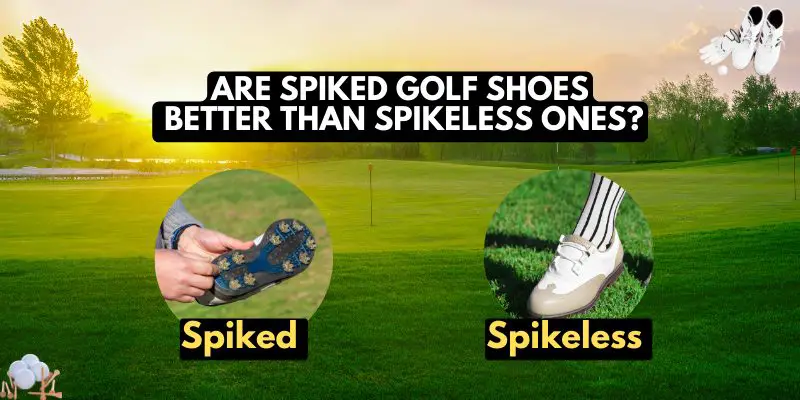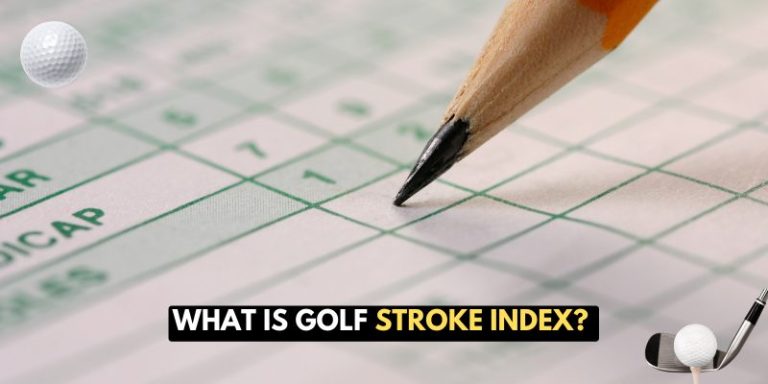Are spiked golf shoes better than spikeless ones?
Are you ready to step up your golf game? One of the most essential elements in improving your swing and overall performance on the green is having solid footing. And when it comes to choosing the right footwear, there’s always been a debate between spiked golf shoes and spikeless ones. Today, we’re diving deep into this age-old question: are spiked golf shoes better than spikeless? Get ready for an enlightening discussion that will help you make an informed decision about which type of shoe can take your game to new heights!
Golf shoes are an essential piece of equipment for any golfer, as they provide stability, traction, and comfort while on the course. While there are various types of golf shoes available on the market, spiked and spikeless golf shoes are two popular options among golfers.
What are golf shoes?
Golf shoes are specially designed footwear that is meant to be worn while playing golf. They come in different styles and designs, but all have one common purpose: to enhance your performance on the course.
Traditionally, golf shoes were made with leather uppers and metal spikes attached to the sole. However, with advancements in technology and materials, modern-day golf shoes now come in a variety of styles, including spiked and spikeless options.
Importance of Golf Shoes
Golf involves a lot of walking over varying terrain conditions, such as grass, sand traps, water hazards, etc. This makes it crucial for players to have proper footwear that can provide them with stability and support throughout their round.
Wearing regular athletic shoes or sneakers may not be ideal for playing 18 holes, as they lack features specifically designed for playing on a golf course. Golf shoes offer superior grip and traction, which help prevent slipping or losing balance during swings.
Moreover, wearing improper footwear can result in foot pain or discomfort, which can affect your swing mechanics negatively. This is why wearing well-fitted golf shoes is important for not only
History of Spiked and Spikeless Golf Shoes
The history of spiked and spikeless golf shoes can be traced back to the early days of golf, when players would wear regular leather dress shoes or boots while on the course. These shoes provided little traction and often caused slipping and sliding, which made it difficult for players to maintain their balance during swings.
In the 19th century, metal spikes were introduced to golf shoes as a way to improve traction on the course. These spikes, also known as cleats, were typically made from iron or steel and were inserted into the sole of the shoe. This innovation revolutionized the game of golf by allowing players to have better stability and grip while swinging their clubs.
However, these early spiked golf shoes were not without their drawbacks. The metal spikes could damage green surfaces and clubhouses, leading many courses to ban them completely. In addition, they were heavy and uncomfortable to wear for extended periods of time.
In the 1990s, a new type of golf shoe emerged: the spikeless shoe. These shoes featured rubber nubs or dimpled patterns on their soles instead of traditional metal spikes. They provided similar levels of traction but without causing damage to courses or discomfort for players.
Ecco created the first spikeless golf shoe in 1996 with their “Ecco Street” model. It quickly gained popularity among professional golfers and amateurs alike due to its sleek design and superior comfort. Other brands soon followed suit with their own versions of spikeless golf shoes, such as Adidas’
Pros and Cons of Spiked Golf Shoes
Spiked golf shoes have been a staple in the sport for many years, providing golfers with traction and stability on the course. However, as spikeless options have become more popular in recent years, there has been an ongoing debate about whether spiked golf shoes are truly better than their spikeless counterparts.
In this section, we will explore the pros and cons of spiked golf shoes to help you make an informed decision when choosing between spiked or spikeless footwear for your next round.
Pros:
- Superior Traction: One of the main advantages of spiked golf shoes is their superior traction. The spikes on the sole of the shoe grip the ground, providing stability and preventing slipping during swings or while walking on wet or uneven terrain. This can be especially helpful during rainy weather or on hilly courses.
- Improved Swing Control: The enhanced grip provided by spiked golf shoes can also help to improve swing control. With solid footing, golfers can generate more power and accuracy in their swings, resulting in better shots.
- Durability: In general, spiked golf shoes tend to be more durable than spikeless ones. The metal or plastic spikes are designed to withstand wear and tear from walking and swinging on various terrains without losing their effectiveness over time.
- Customizable Spikes: Some spiked golf shoe models allow for customizable spikes, allowing players to adjust the length or type of spikes based on personal preference or course conditions. This feature can come in handy for players who prefer different levels.
Cons:
- Limited Versatility: Spiked shoes may not perform as well on dry or harder surfaces like concrete or artificial turf. This limitation could affect comfort and natural movement during walking.
- Heavier Weight: Spiked shoes tend to be heavier due to the metal spikes, which could lead to some discomfort during prolonged periods of walking.
Pros and Cons of Spikeless Golf Shoes
When it comes to choosing the right golf shoes, one of the main factors to consider is whether to go for spiked or spikeless options. While traditional spiked golf shoes have been around for decades, spikeless golf shoes have gained popularity in recent years. Both types have their own advantages and disadvantages, and ultimately, the decision depends on personal preference and playing style. In this section, we will discuss the pros and cons of spikeless golf shoes.
Pros:
- Versatility: One of the biggest advantages of spikeless golf shoes is their versatility. They can be worn on and off the course, making them a great option for players who want a shoe that can transition seamlessly from game to everyday wear.
- Comfort: Spikeless golf shoes are designed with comfort in mind. They usually have a more relaxed fit compared to spiked shoes and do not require any breaking-in period.
- Lightweight: Without bulky spikes attached to the sole, spikeless golf shoes are significantly lighter than their spiked counterparts. This can make a noticeable difference in terms of fatigue during long rounds of play.
- Traction: While they may not provide as much traction as spiked shoes on wet or hilly terrain, modern spikeless designs offer excellent grip thanks to advanced rubber outsoles with various patterns and textures.
- Durability: With no spikes that need replacing over time, spikeless golf shoes tend to last longer than spiked ones.
Cons:
- Less traction on certain terrains: As mentioned earlier,

Factors to Consider When Choosing Between Spiked and Spikeless Golf Shoes
When it comes to choosing the right golf shoes, one of the main decisions you will have to make is whether to go for spiked or spikeless options. Both types of golf shoes offer their own unique benefits, and it can be challenging to determine which one is best for your game. To help you make an informed decision, here are some important factors to consider when choosing between spiked and spikeless golf shoes:
- Course Conditions: The type of course you typically play on should play a major role in deciding between spiked or spikeless golf shoes. If you tend to play on wet or hilly courses, then spiked shoes may be the better option, as they provide more traction and stability on slippery surfaces. On the other hand, if you mostly play on dryer courses with flatter terrain, then spikeless shoes may be a more comfortable and practical choice.
- Playing Style: Your personal playing style can also influence your shoe choice. For players who have a powerful swing, spiked shoes can provide more grip and support during swings, helping to maintain balance and prevent slipping. However, if you have a smoother swing and tend to focus more on accuracy than distance, then spikeless shoes may offer enough traction without compromising flexibility.
- Comfort: Comfort is key when it comes to any type of footwear, especially when spending several hours walking around a golf course. Spikeless golf shoes are often praised for their comfort, as they are designed with flexible soles that conform to the natural movement of your feet.
Top Brands for Spiked and Spikeless Golf Shoes
When it comes to choosing the right golf shoes, one of the main decisions you’ll have to make is whether to go for spiked or spikeless options. While both types have their own benefits and drawbacks, one thing is for sure: having a reliable and well-known brand can make all the difference in your game.
So, if you’re considering investing in a new pair of golf shoes and are looking for top-quality brands in both spiked and spikeless categories, here are some of our recommendations:
Nike
Nike has been a leader in the sports footwear industry for decades, and their golf shoe collection is no exception. Their spiked shoes feature a combination of soft cushioning and durable traction to give you the support you need on the course. Meanwhile, their spikeless offerings focus on lightweight comfort and flexibility without sacrificing grip.
FootJoy
FootJoy is another popular brand among golfers worldwide, known for its high-quality materials and innovative designs. Their spiked shoes use advanced technology such as BOA lacing systems or proprietary cleat systems to provide maximum stability and traction. On the other hand, their spikeless models offer exceptional breathability and versatility for those who prefer a more casual look.
Adidas
Adidas may be best known for its athletic wear, but their golf shoe line also deserves recognition. With features like waterproof protection, responsive cushioning, and excellent grip on both wet and dry surfaces, Adidas offers reliability in any playing condition with their spiked shoes. Their spikeless
Tips for Maintaining and Cleaning Your Golf Shoes
Golf shoes are an essential part of any golfer’s equipment. They not only provide support and stability during the swing but also help maintain traction on the course, preventing slips and falls. However, to ensure that your golf shoes perform at their best and last for a long time, proper maintenance and cleaning are crucial. Here are some tips for maintaining and cleaning your golf shoes:
- Brush off any dirt or debris after each use. After playing a round of golf, it is important to remove any dirt or grass clippings from your golf shoes. Use a soft-bristled brush or cloth to gently wipe away any debris on the surface of the shoe.
- Clean with mild soap and water. If your golf shoes have visible stains or marks, you can use mild soap and water to clean them. Dip a clean cloth in soapy water and gently rub over the stained area until it is removed. Be sure to rinse off all soap residue with a damp cloth afterwards.
- Dry properly: After cleaning your golf shoes, be sure to dry them thoroughly before storing them away. Avoid using direct heat sources such as hair dryers or heaters, as they can damage the materials of the shoe. Instead, stuff newspaper inside the shoes to absorb excess moisture and let them air dry in a well-ventilated area.
- Protect against water damage: Golf courses can often be wet or muddy, which can cause damage to your golf shoes if not properly protected. Consider investing in waterproofing.
Which is Better: Spiked or Spikeless?
After considering the various factors and differences between spiked and spikeless golf shoes, it is clear that there is no definitive answer to which one is better. It ultimately comes down to personal preference and individual playing style.
However, there are certain scenarios where one type of shoe may have an advantage over the other. Let’s take a closer look at these situations to help you make a more informed decision.
Traction on Different Terrains
Spiked golf shoes are known for their superior traction on wet or slippery surfaces, such as dewy grass or muddy terrain. This is due to the sharp metal spikes that dig into the ground, providing stability and preventing slipping during swings.
On the other hand, spikeless golf shoes offer a more versatile grip on different terrains. They may not provide the same level of traction as spiked shoes on wet surfaces, but they perform well on dry grass and harder surfaces like concrete or artificial turf.
Comfort and convenience
Spikeless golf shoes are often praised for their comfort and convenience. With no protruding spikes, they tend to be lighter and more flexible than their spiked counterparts, allowing for a more natural motion while walking or swinging.
They also do not require constant replacement of worn-out spikes, saving players time and money in the long run. However, some players may find that they sacrifice some stability in exchange for this convenience.
Durability
When it comes to durability, spiked golf shoes have an edge over spikeless ones. The metal spikes provide a robust grip and are typically more durable in the long term. They are less prone to wear and tear, making them a reliable choice for avid golfers who frequently play in challenging conditions.
In contrast, spikeless golf shoes might wear down faster, especially if used extensively on abrasive surfaces like concrete or rocky terrain. The absence of spikes means that the shoe’s sole, which directly contacts the ground, is more susceptible to wear.
Final Consideration
In the end, the choice between spiked and spikeless golf shoes boils down to personal preference and how and where you predominantly play. If you often find yourself on wet or uneven terrain, spiked shoes might offer the stability and grip you need. Alternatively, if you value comfort, versatility, and don’t mind sacrificing a bit of traction on certain surfaces, spikeless shoes could be the ideal choice.
It’s also worth considering having both types of shoes in your golfing arsenal. This way, you can switch between them based on the weather conditions and the golf course you’re playing on. Ultimately, your comfort, playing style, and the specific conditions you encounter on the golf course should guide your decision, ensuring an enjoyable and optimal golfing experience every time you hit the links.







One Comment